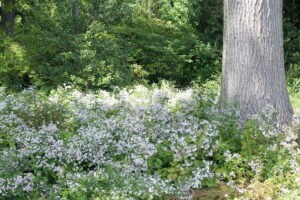White wood aster
* Common name: White wood aster

White wood aster makes a durable native groundcover under and around trees.
* Botanical name: Eurybia divaricata
* What it is: Not many plants are happy underneath big trees where the shade and root competition creates very challenging conditions. White wood aster is one of them.
What’s more, this August/September bloomer is a Pennsylvania-native perennial that offers late-season pollen and nectar to pollinators.
White wood aster is a somewhat tall, bushy perennial that doesn’t get around to blooming until most everything else is winding down. Then it sends up inch-wide, daisy-like flowers that have narrow white petals (almost like rays) and yellow centers.
Plants are drought-tough and trouble-free.
* Size: Grows two to two-and-a-half feet tall with a similar spread. Unlike most asters, white wood aster prefers to grow in shade or part shade as opposed to full sun.
* Where to use: One of this plant’s best uses is massed as a tall groundcover under and around shade trees. It’s also useful mixed in any shade or woodland garden.
* Care: Keep the soil damp the first season to establish the roots, then water is usually not needed.
Cut plants to the ground in early spring just before new growth begins, and scatter a balanced organic or slow-acting granular fertilizer formulated for flowers around the plants after the cut.
If you want to expand your plantings, white wood aster clumps can be dug in early spring, divided, and replanted.
* Great partner: White wood aster doesn’t need a partner if you’re massing it as a groundcover under trees. Otherwise, variegated Solomon’s seal is a good perennial partner that tolerates dry shade and has white-variegated foliage that coordinates with white wood aster’s white blooms. Arrowwood viburnum and spicebush are two good native shrubs that work in similar settings.







